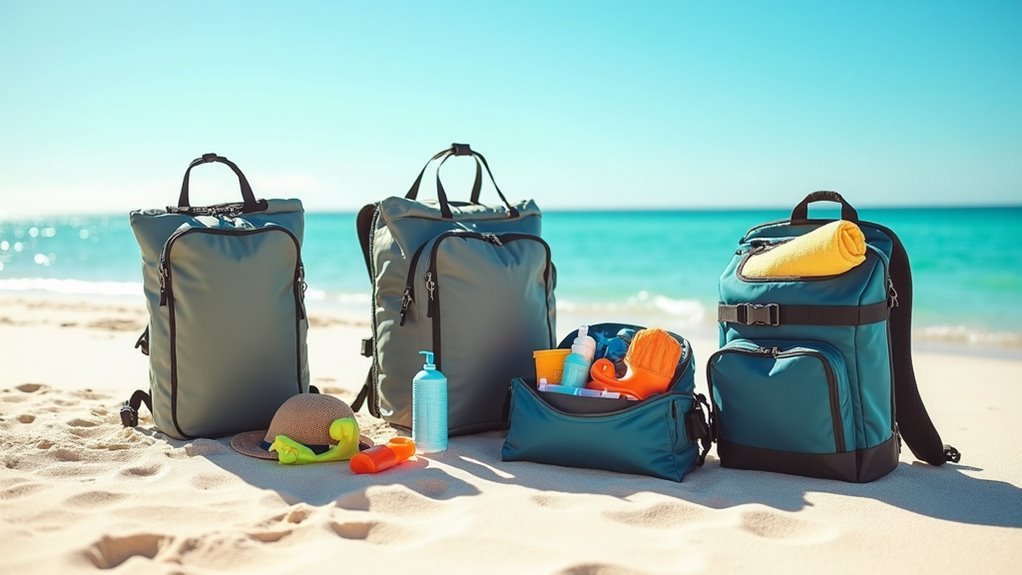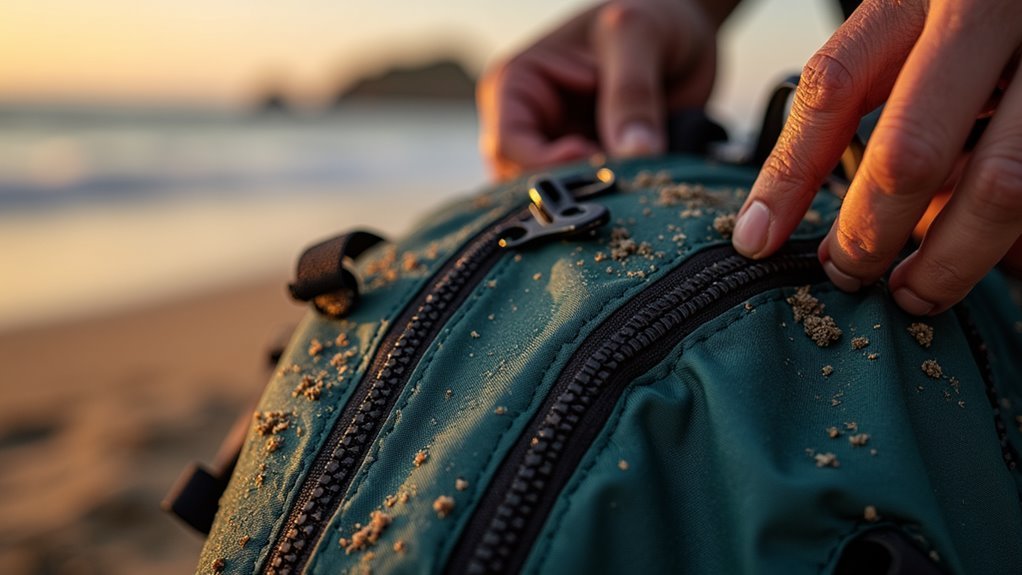When I’m selecting a beach backpack, I focus on three main areas that’ll save you headaches later. First, match the size to your actual needs—small daypacks work for quick trips, while weekend getaways need larger capacity. Second, prioritize durability over fancy features; I’ve learned that quality zippers and double-stitched seams matter more than extra pockets. Finally, research thoroughly by reading customer reviews and comparing prices, though perhaps the warranty terms get overlooked too often. These fundamentals will guide you toward the perfect choice for your coastal adventures.
Understanding Beach Backpack Types and Features

When you’re standing in front of a wall of beach backpacks at the store, it’s honestly a bit overwhelming at first. I think the sheer variety can make your head spin – there’s everything from simple drawstring styles to elaborate multi-compartment designs.
You’ve got your basic daypacks, which are perfect if you’re the type who travels light. Then there are larger expedition-style bags with multiple pockets, though perhaps they’re overkill for a simple beach day.
Some feature waterproof materials, others focus on ventilation. The key is matching features to your actual needs, not getting caught up in every bell and whistle available.
Determining the Right Size and Storage Capacity
Three different beach trips typically require three completely different bag sizes, and I’ve learned this the hard way.
For quick sunset walks, I think a small daypack works perfectly—just enough room for sunscreen, phone, and maybe a water bottle.
Weekend getaways demand something larger though. I need space for towels, snacks, and all those random items that somehow become essential.
Multi-day adventures? That’s where I go big or regret it later.
Perhaps it’s overkill, but having extra compartments for wet clothes and sandy gear makes the difference between organized freedom and chaotic frustration.
Size really does matter here.
Evaluating Durability and Material Quality

After buying my third beach backpack in two years, I’ve become somewhat obsessed with material quality—though perhaps that’s just frustration talking.
Salt air and sand are brutal on fabrics, I’ve learned.
Here’s what I now check religiously:
- Fabric weight and weave – Lightweight ripstop nylon holds up better than canvas, surprisingly.
- Zipper quality – YKK zippers cost more but they’re worth every penny when sand gets everywhere.
- Seam construction – Double-stitched seams prevent catastrophic failures mid-trip.
I think polyester fades less than nylon, but honestly, both work fine if you’re not leaving your pack in direct sunlight constantly.
Making Smart Purchase Decisions Through Research
Since I’ve blown through so many beach bags over the years, I’ve gotten pretty methodical about my research process—though I’ll admit I still sometimes get swayed by a really cool pattern. Reading reviews is honestly where I find the most valuable insights. People mention things like zippers breaking after three months or sand getting stuck in compartments that manufacturers never talk about.
| Research Factor | Why It Matters |
|---|---|
| Customer Reviews | Real-world durability insights |
| Price Comparison | Avoid overpaying for features |
| Return Policy | Freedom to change your mind |
| Warranty Terms | Protection for your investment |
Perhaps most importantly, I always check return policies before buying anything online.
Frequently Asked Questions
How Do I Clean and Maintain My Beach Backpack After Saltwater Exposure?
An ounce of prevention’s worth a pound of cure. I’ll rinse your backpack thoroughly with fresh water, scrub gently with mild soap, then air-dry completely to prevent salt damage and extend its adventurous life.
Can Beach Backpacks Be Used as Carry-On Luggage for Flights?
I’d check your airline’s carry-on size restrictions first. Most beach backpacks work perfectly as carry-on luggage since they’re designed for travel. You’ll have everything you need organized and accessible during your flight.
What’s the Best Way to Organize Wet and Dry Items Separately?
I’d recommend using waterproof pouches or dry bags inside your backpack to separate wet swimwear from dry electronics and clothes. You’ll keep everything organized while protecting your valuables from moisture damage.
Are There Beach Backpacks Specifically Designed for Children or Families?
Over 70% of families struggle with beach gear organization, but yes, there are dedicated family beach backpacks featuring compartmentalized designs, kid-friendly colors, and extra capacity that’ll liberate you from chaotic beach trips and missing essentials.
How Do I Prevent Sand From Getting Stuck in Zippers and Compartments?
I’ll choose backpacks with sealed, water-resistant zippers and shake out sand frequently. I’ll also pack items in waterproof pouches, keep zippers closed when not needed, and rinse the bag after beach trips.
Conclusion
Think of choosing a beach backpack like finding the perfect wave – you’ll know it’s right when everything clicks into place. I’ve learned that rushing this decision usually leads to regret. Take your time comparing materials, testing weight distribution, and perhaps most importantly, considering how you actually use your gear. The right backpack becomes an extension of yourself, making every beach day more enjoyable and stress-free.